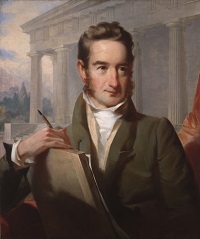William Strickland
1788-1854
Born in Navesink, New Jersey, Strickland's father was a master carpenter and a member of the Practical House Carpenters' Society. Strickland's father worked on the Bank of Pennsylvania which brought his son William to the attention of Benjamin Latrobe, the architect of the bank. William apprenticed with Latrobe for two years until he left to try his hand at painting.
In 1815 he submitted a design for the Second Bank of the United States which instantly thrust him to the vanguard of the architectural profession. The Second Bank, modeled on the Greek Parthenon, was one of the first Greek Revival buildings in the United States, and led to other commissions.
Active in social and cultural affairs, Strickland was a member of the American Philosophical Society, the Franklin Institute, and the Musical Fund Society.
Despite his reputation, he lost the prestigious competitions to design Girard College to ex-student Thomas U. Walter; Laurel Hill Cemetery and the Philadelphia Athenaeum to John Notman; and the Franklin Institute to John Haviland.
In 1837, a financial panic in Philadelphia curtailed all commissions, causing Strickland to head south. He died during the construction of his last major work, the State House in Nashville, Tennessee. He is entombed beneath that building, which today is featured on Tennessee license plates.
STRICKLAND BUILDINGS
- Second Bank of the United States (1818-24)
- St. John's Episcopal Church — American and Brown Streets (today Rumanian Orthodox)
- St. Stephen's Episcopal (1822-23) — 19 S. 10th
- Mariner's Church (1824) — 20 S. 3rd Street (today houses a micro-brewery)
- Musical Fund Society Hall (1824) — 808 Locust St. (venue for the first Republican Convention in 1856)
- Merchants' Exchange (1832-34) — 143 S. 3rd
- Wyck (1826, alterations and additions) — Germantown Ave.
- U.S. Naval Home (1826-29) — 24th and Gray's Ferry.
- Tennessee State Capital (1845-47)
BUILDINGS DEMOLISHED
- Masonic Hall (1808-11; demolished 1852) — bet. 7th and 8th on Chestnut
- Asylum for the Insane (1815-17)
- Chestnut Street Theater (demolished 1856) — between 6th and 7th
- Mikveh Israel Synagogue (1822-25; demolished 1860) — Cherry St. near 3rd
- Triumphal arches for Lafayette's visit (1824)
- Arch St. Theater (1829; demolished 1936) — 6th St.
- University of Pennsylvania; Main and Medical Halls — (1829) 9th and Market
- U.S. Mint (1829-33; demolished 1907) — Chestnut and Juniper



